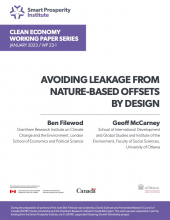By: Ben Filewod and Geoff McCarney
If nature-based offsets are to play a role in critical near-term climate change mitigation efforts, they must provide a credible alternative to emissions reductions. In Avoiding Leakage from Nature-Based Offsets by Design, the authors argue that scaling up nature-based solutions is challenged by the continued lack of an accurate and cost-effective method for measuring market leakage at the project level. Yet currently, transactions of nature-based offsets in both compliance and voluntary markets reflect an underlying assumption that approaches to managing leakage at the project level are working.
The authors show that leading third-party certification standards appear to vastly understate leakage compared with the research literature, and argue that the tools available for project-level crediting cannot deliver the accuracy needed in practice. To help nature-based offsets reach their potential,they propose an alternative, conservative, approach for avoiding leakage ‘by design’.
The authors present a new framework for identifying and avoiding market leakage, based on understanding the relationship between additionality and leakage in an economic equilibrium. They then identify three principles that offset developers and certifiers should implement to improve the credibility of nature-based offset markets, while also allowing for increasing ambition and investment in nature-based solutions.
Key points for decision-makers
- Nature-based solutions protect, restore, or manage ecosystems to meet societal challenges such as global warming. When implemented for mitigation, nature-based solutions can be funded by the sale of carbon offsets.
- Leakage occurs when some effects of an offset occur outside the project’s carbon accounting boundary (e.g. an action causing emissions reductions in one place may also cause increases elsewhere).
- Project-level accounting and certification by a third-party standard is the primary tool used to manage market leakage, but the approaches in use appear to significantly underestimate the likely magnitude of market leakage effects, introducing a risk of ‘silent failure’ into nature-based offset regimes.
- In the authors’ conceptual framework, designing out market leakage depends on recognising the ‘duality’ between leakage and additionality. For an offset to be ‘additional’, it must change the state of the world; this produces general equilibrium effects in markets that extend beyond project-level accounting boundaries.
- The authors identify three principles for avoiding market leakage by design. First, nature-based offsets that reduce supply to markets should not substitute for avoided emissions. Second, the standard of certainty for avoiding market leakage risk should be set by the nature of the substituted action. Third, when risk of market leakage is present in nature-based offset projects, upper bound estimates should be used.
- The framework and principles for a design-based approach could contribute to improving the credibility of nature-based offset markets, helping this important set of mitigation strategies realise their potential.
READ THE WORKING PAPER: Avoiding Leakage from Nature-Based Offsets by Design
Suggested Citation: Filewood, Ben and McCarney, Geoff. Avoiding Leakage from Nature-Based Offsets by Design (January, 2023). Available at the Smart Prosperity Institute Clean Economy Working Paper Series: https://institute.smartprosperity.ca/publications/avoiding-leakage-by-design
The Clean Economy Working Paper Series disseminates findings of ongoing environmental and clean economy work conducted by researchers from a range of disciplines. These working papers are meant to make results of relevant scholarly work available in a preliminary form. Although these papers have not undergone a peer-review process, they meet general standards of scholarly excellence. The views expressed in these working papers are those of the authors and do not necessarily reflect the opinions of Smart Prosperity Institute.



